A Design Methodology for Low-Loss Interconnects Featuring Air Cavities and Periodically Nonuniform Widths
Abstract
:Featured Application
Abstract
1. Introduction
2. Materials and Methods
2.1. Challenges in the Current State of the Art
2.2. Transmission Structure Addressing the Current Challenge
2.3. Supporting Structure
2.4. Demonstration Setup and Parameters
3. Results
3.1. SICL Incorporating the Proposed Design Methodology
3.1.1. Loss Reduction
3.1.2. Improvement in Impedance Matching
3.2. Stripline Incorporating the Proposed Design Methodology
3.2.1. Loss Reduction
3.2.2. Improvement in Impedance Matching
3.2.3. The Optimal Design of the Density of Air Cavities
3.2.4. Process Tolerance of the Distance Between the Air Cavities and the Metal Line
3.2.5. Study on the Applicability of the Methodology
4. Discussion
5. Patents
Author Contributions
Funding
Institutional Review Board Statement
Informed Consent Statement
Data Availability Statement
Conflicts of Interest
References
- Kissinger, D.; Kaynak, M.; Mai, A. Integrated millimeter-wave and terahertz analyzers for biomedical applications. IEEE Trans. Microw. Theory Tech. 2022, 70, 5141–5158. [Google Scholar] [CrossRef]
- Piovesan, T.; Prado, E.; Sartori, H.C.; Pinheiro, J.R. Analytical electro-thermal model and 3-D thermal resistance network for SMD-based printed circuit board power converters. IEEE J. Emerg. Sel. Top. Power Electron. 2024, 12, 4979–4992. [Google Scholar] [CrossRef]
- Min, Q.; Li, E.-P.; Jin, J.-M.; Chen, W. Electrical–thermal cosimulation of coaxial TSVs with temperature-dependent MOS effect using equivalent circuit models. IEEE Trans. Electromagn. Compat. 2020, 62, 2247–2256. [Google Scholar] [CrossRef]
- Köroğlu, Ç.; Pop, E. High thermal conductivity insulators for thermal management in 3D integrated circuits. IEEE Electron Device Lett. 2023, 44, 496–499. [Google Scholar] [CrossRef]
- Helou, A.; Venugopal, A.; Raad, P.E. Compact 3D thermal model for VLSI and ULSI interconnect network reliability verification. IEEE Trans. Device Mater. Reliab. 2021, 21, 240–251. [Google Scholar] [CrossRef]
- Nericua, R.; Wang, K.; Zhu, H.; Gómez-García, R.; Zhu, X. Low-loss and compact millimeter-wave silicon-based filters: Overview, new developments in silicon-on-insulator technology, and future trends. IEEE J. Emerg. Sel. Top. Circuits Syst. 2024, 14, 30–40. [Google Scholar] [CrossRef]
- Li, C.-H.; Chiu, T.-Y. Low-loss single-band, dual-band, and broadband mm-wave and (sub-)THz interconnects for THz SoP heterogeneous system integration. IEEE Trans. Terahertz Sci. Technol. 2022, 12, 130–143. [Google Scholar] [CrossRef]
- Pfahler, T.; Scheder, A.; Bridier, A.; Schür, J.; Vossiek, M. A low-loss bond-wire interconnect design with more than 130 GHz bandwidth enabling an ultra-broadband heterogeneous system design. IEEE Trans. Microw. Theory Tech. 2024, 72, 505–515. [Google Scholar] [CrossRef]
- Yu, B.; Liu, Y.; Ye, Y.; Liu, X.; Gu, Q.J. Low-loss and broadband G-band dielectric interconnect for chip-to-chip communication. IEEE Microw. Wirel. Compon. Lett. 2016, 26, 478–480. [Google Scholar] [CrossRef]
- Khac Le, H.; Kim, S. Machine Learning Based Energy-Efficient Design Approach for Interconnects in Circuits and Systems. Appl. Sci. 2021, 11, 915. [Google Scholar] [CrossRef]
- Gatti, F.; Bozzi, M.; Perregrini, L.; Wu, K.; Bosisio, R.G. A novel substrate integrated coaxial line (SICL) for wide-band applications. In Proceedings of the 2006 European Microwave Conference, Manchester, UK, 10–15 September 2006. [Google Scholar]
- Xu, F.; Wu, K. Guided-wave and leakage characteristics of substrate integrated waveguide. IEEE Trans. Microw. Theory Tech. 2005, 53, 66–73. [Google Scholar]
- Wu, K.; Bozzi, M.; Fonseca, N.J.G. Substrate integrated transmission lines: Review and applications. IEEE J. Microw. 2021, 1, 345–363. [Google Scholar] [CrossRef]
- Kim, M.; Bae, B.; Cheon, J. Experimental characterization of millimeter-wave substrate-integrated waveguide interconnect with slot transition in flexible printed circuit boards. Electronics 2022, 11, 2995. [Google Scholar] [CrossRef]
- Nwajana, A.O.; Obi, E.R. A review on SIW and its applications to microwave components. Electronics 2022, 11, 1160. [Google Scholar] [CrossRef]
- Lu, C.; Yang, L.; Yin, X.; Zhao, H.; Liu, L. Very low crosstalk measurement of substrate integrated coaxial line (SICL). Electronics 2019, 8, 1174. [Google Scholar] [CrossRef]
- Shao, Y.; Li, X.-C.; Wu, L.-S.; Mao, J.-F. A wideband millimeter-wave substrate integrated coaxial line array for high-speed data transmission. IEEE Trans. Microw. Theory Tech. 2017, 65, 2789–2800. [Google Scholar] [CrossRef]
- Ning, K.; Li, X.C.; Shao, Y.; Mao, J.F. Low-loss wide-bandwidth planar transmission line with a laminated conductor. Sci. China Inf. Sci. 2023, 66, 152304. [Google Scholar] [CrossRef]
- Belenguer, A.; Borja, A.L.; Esteban, H.; Boria, V.E. High-performance coplanar waveguide to empty substrate integrated coaxial line transition. IEEE Trans. Microw. Theory Tech. 2015, 63, 4027–4034. [Google Scholar] [CrossRef]
- Isapour, A.; Kouki, A.B. Empty LTCC integrated waveguide with compact transitions for ultra-low loss millimeter-wave applications. IEEE Microw. Wirel. Compon. Lett. 2017, 27, 144–146. [Google Scholar] [CrossRef]
- Rehman, M.; Kumar, L.N.; Erdogan, V.S.; Swaminathan, M. Air-filled SIWs using laminate dielectrics on glass substrate for D-band applications. IEEE Trans. Compon. Packag. Manuf. Technol. 2024, 14, 98–105. [Google Scholar] [CrossRef]
- Sun, C.-S.; Li, X.-C.; Zhan, H.-B.; Ning, K. A low-loss and high-bandwidth hollow rectangular dielectric waveguide for sub-THz applications. IEEE Trans. Microw. Theory Tech. 2024, 72, 5961–5969. [Google Scholar] [CrossRef]
- Noguchi, J.; Sato, K.; Konishi, N.; Uno, S.; Oshima, T.; Ishikawa, K.; Ashihara, H.; Saito, T.; Kubo, M.; Tamaru, T.; et al. Process and reliability of air-gap Cu interconnect using 90-nm node technology. IEEE Trans. Electron Devices 2005, 52, 352–359. [Google Scholar] [CrossRef]
- Noguchi, J.; Oshima, T.; Matsumoto, T.; Uno, S.; Sato, K. Multilevel interconnect with air-gap structure for next-generation interconnections. IEEE Trans. Electron Devices 2009, 56, 2675–2682. [Google Scholar] [CrossRef]
- Spencer, T.J.; Joseph, P.J.; Kim, T.H.; Swaminathan, M.; Kohl, P.A. Air-gap transmission lines on organic substrates for low-loss interconnects. IEEE Trans. Microw. Theory Tech. 2007, 55, 1919–1925. [Google Scholar] [CrossRef]
- Kumar, V.; Sharma, R.; Uzunlar, E.; Zheng, L.; Bashirullah, R.; Kohl, P.; Bakir, M.S.; Naeemi, A. Airgap interconnects: Modeling, optimization, and benchmarking for backplane, PCB, and interposer applications. IEEE Trans. Compon. Packag. Manuf. Technol. 2014, 4, 1335–1346. [Google Scholar] [CrossRef]
- Green, H.E. Conductor geometry independence of phase velocity in TEM-mode transmission lines. IEEE Trans. Microw. Theory Tech. 1989, 37, 805. [Google Scholar] [CrossRef]
- Wilcoxon, R. The effects of geometry and dielectric material on stripline and microstrip internal temperatures. IEEE Trans. Compon. Packag. Technol. 2005, 28, 674–679. [Google Scholar] [CrossRef]
- Liu, X.; Zhu, Y.; Yang, Y.; Ding, R. Low-loss air-cavity through-silicon vias (TSVs) for high speed three-dimensional integrated circuits (3-D ICs). IEEE Microw. Wirel. Compon. Lett. 2016, 26, 89–91. [Google Scholar] [CrossRef]
- A6M/A6M-E High Frequency LTCC Tape System. Available online: http://www.ferro.com/Our+Products/ColorsGlass/Electronic/Electronic-Materials/docs/A6M%20A6M-E%20LTCC%20Tape%20System.pdf (accessed on 1 January 2017).
- Kumar, A.; Viswambharaet, P.; Surendranath, K.; Srivastava, P.K.; Chaturvedi, I.; Singh, H.; Prajapati, K.; Parmar, H.; Naranbhai, L.R.; Sinha, S.; et al. Defect free lamination of low temperature co-fired ceramic multi-chip-modules. In Proceedings of the 2024 International Conference on Integrated Circuits, Communication, and Computing Systems, Una, India, 8–9 June 2024. [Google Scholar]
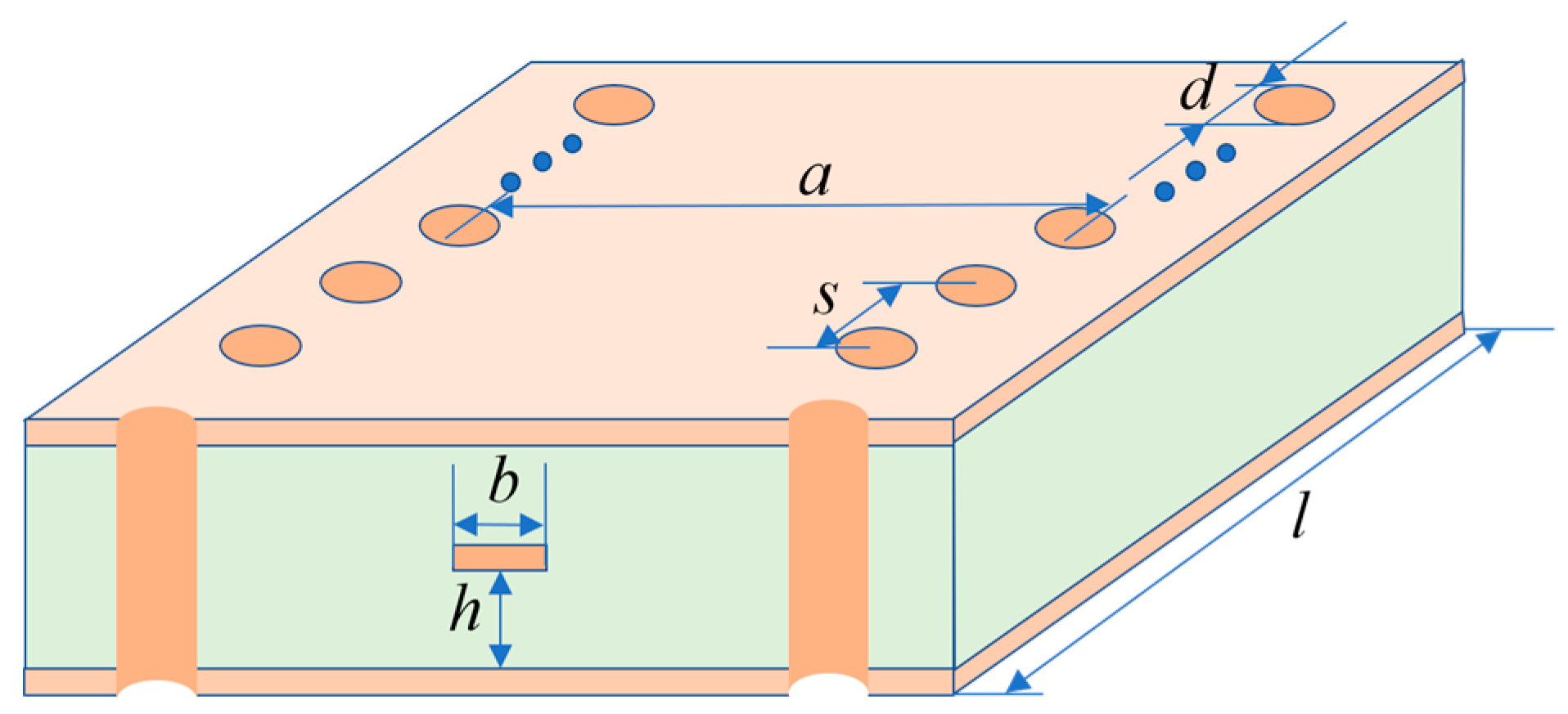


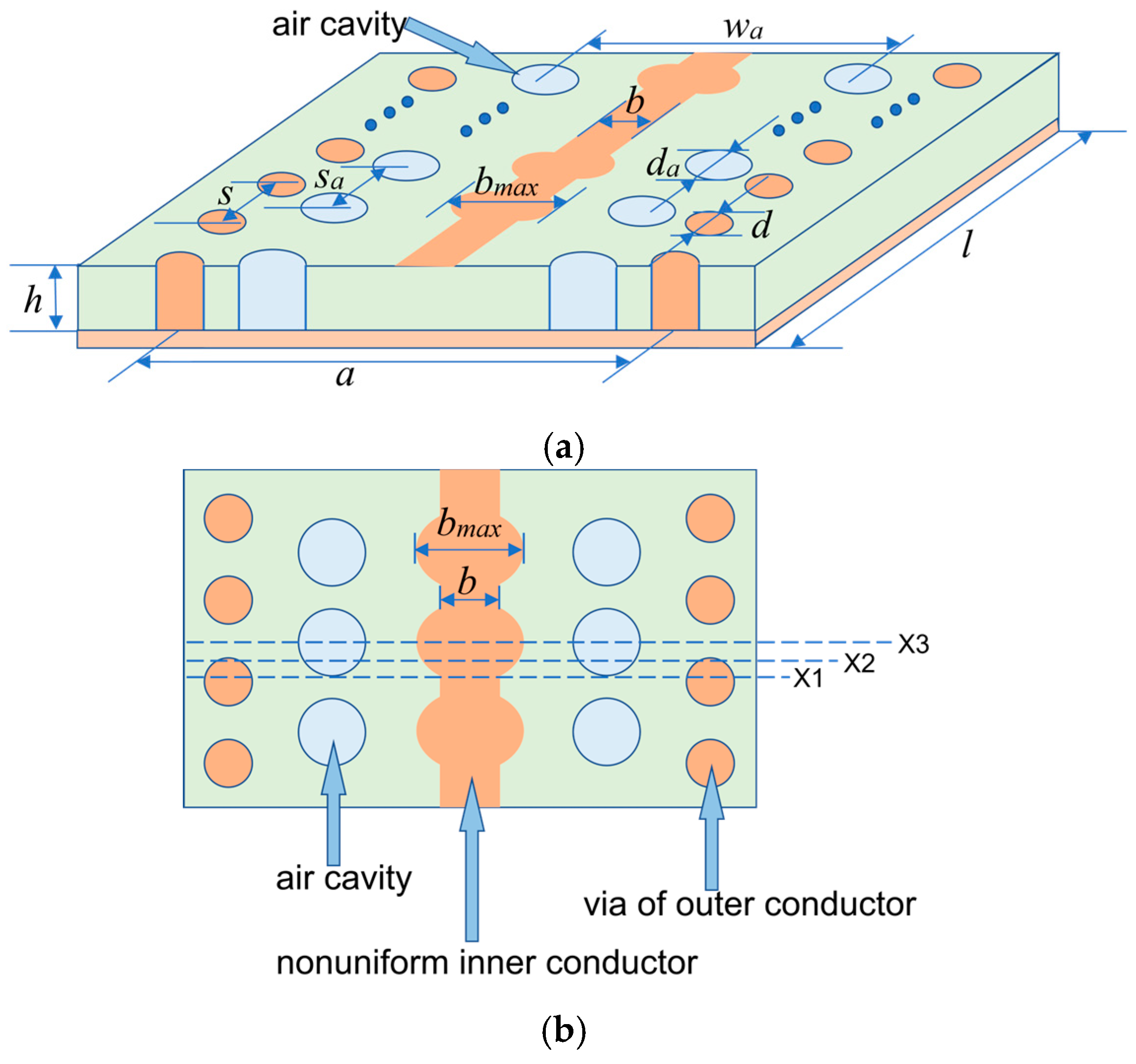
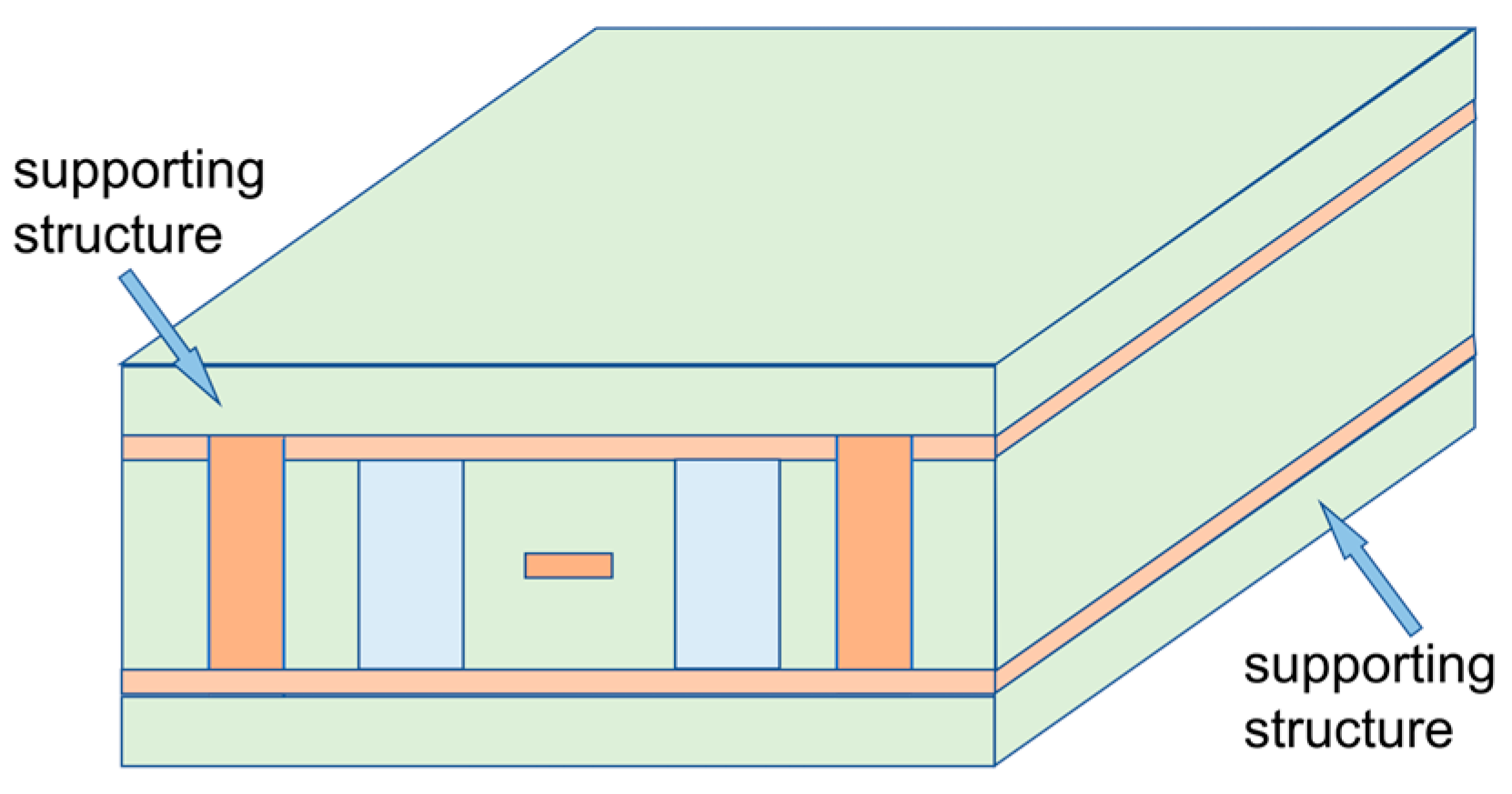


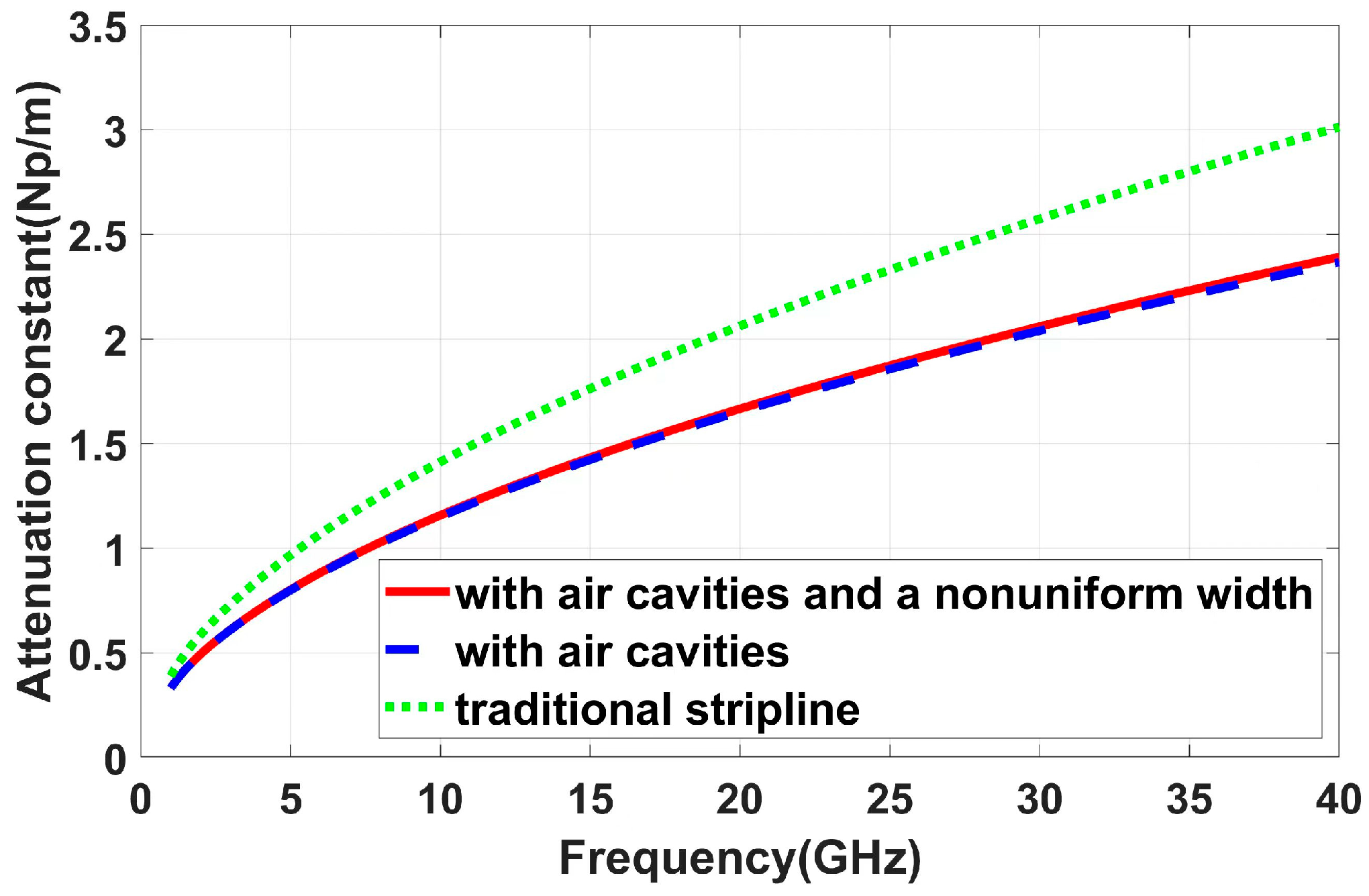
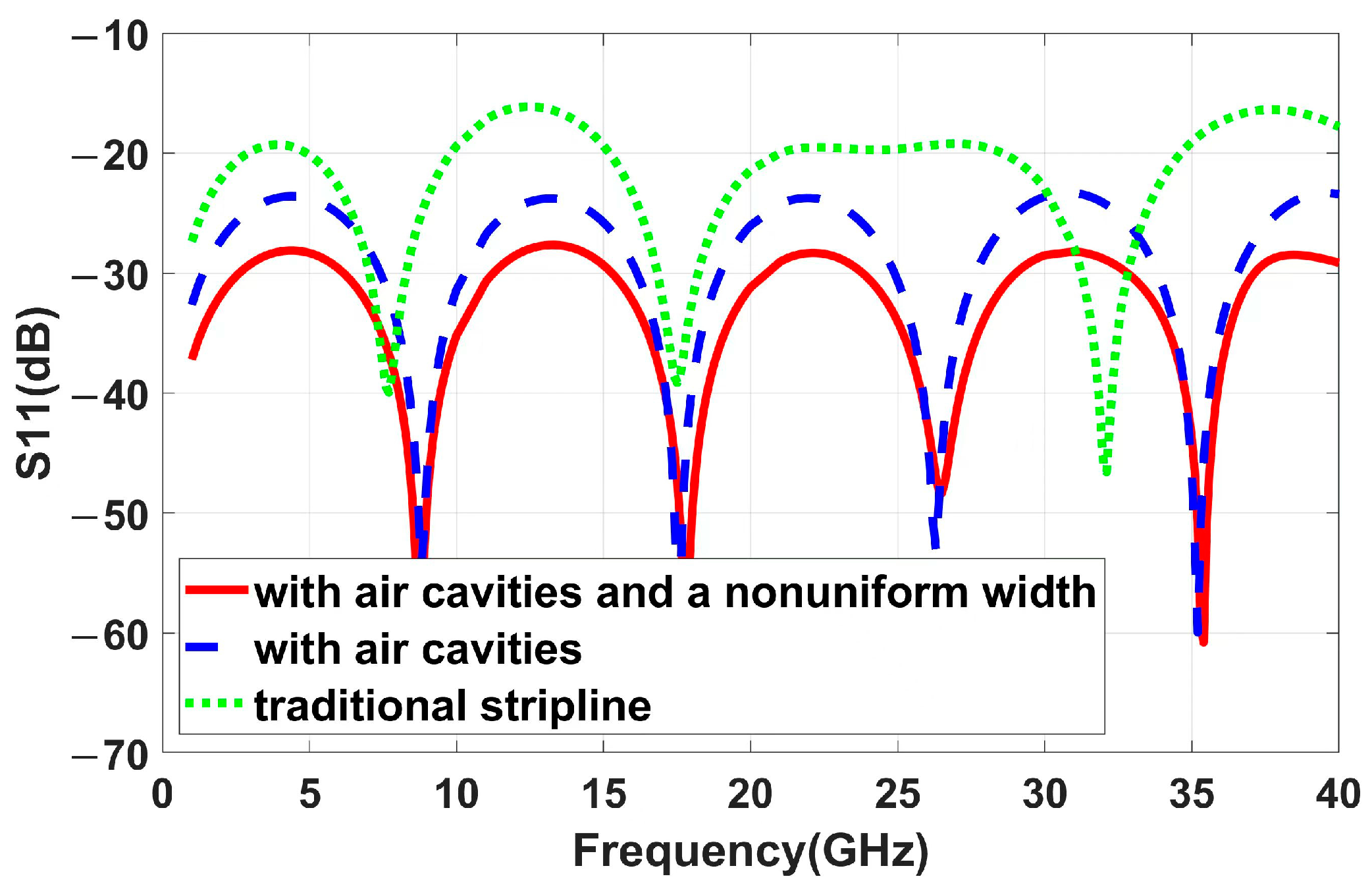
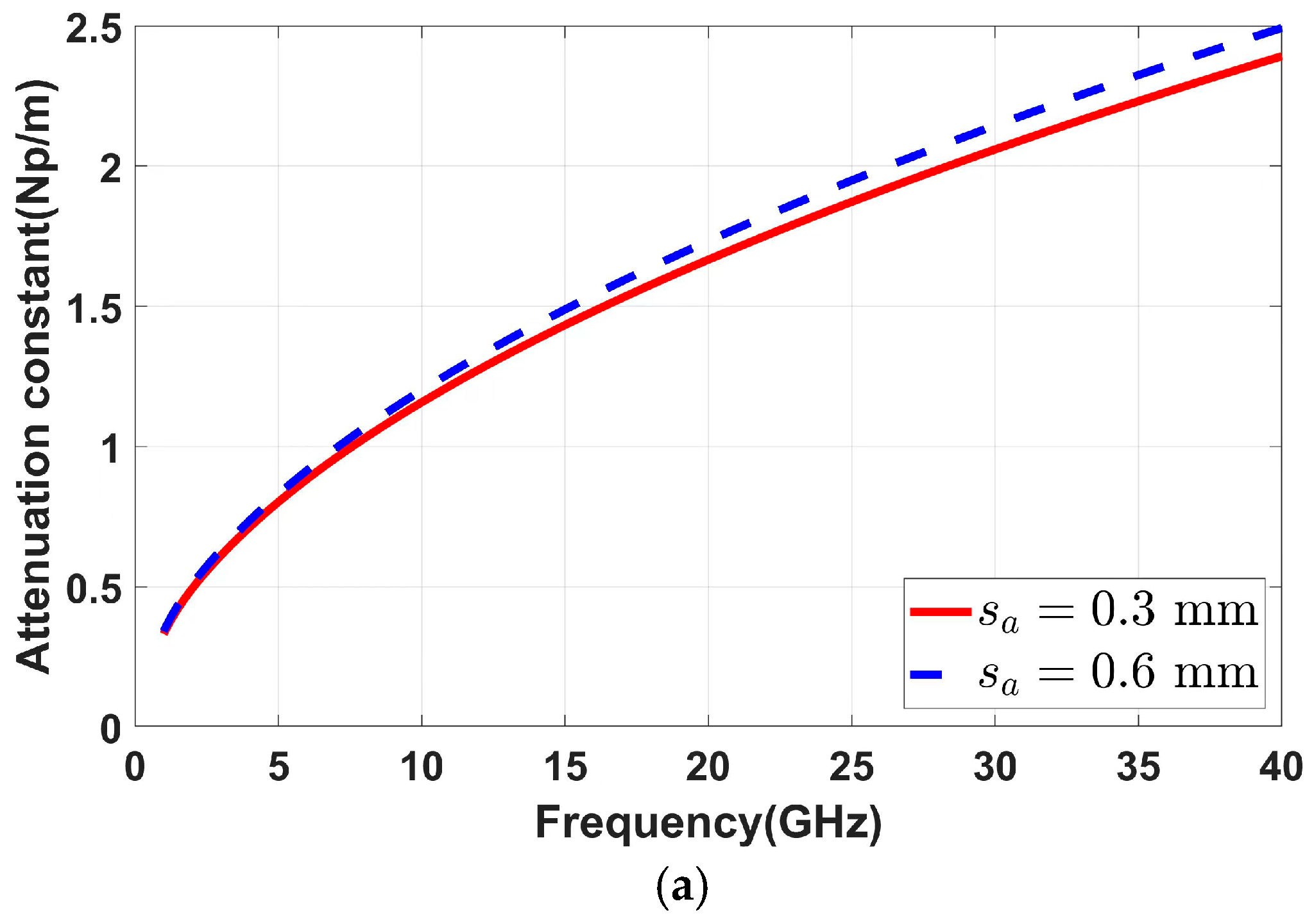
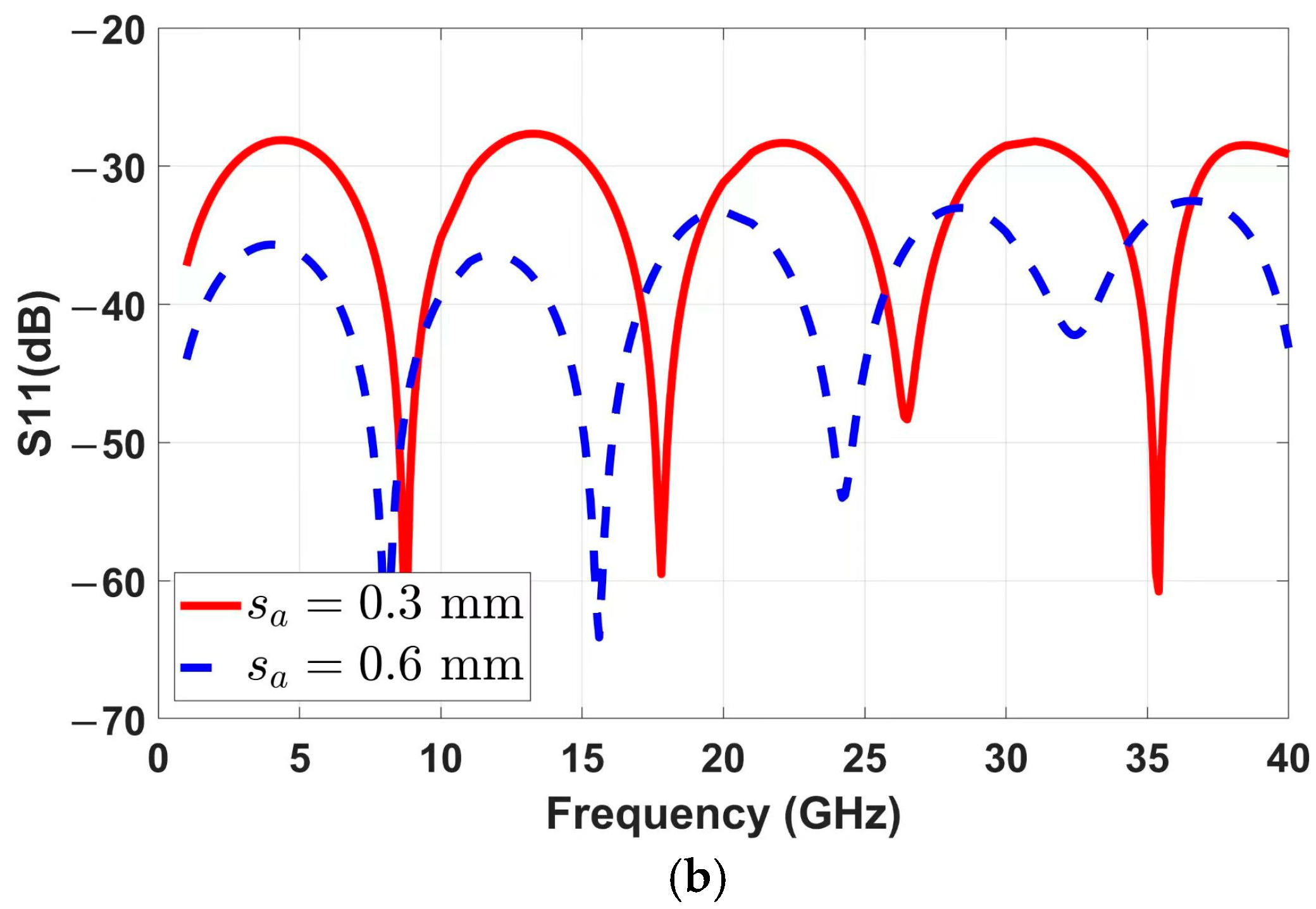
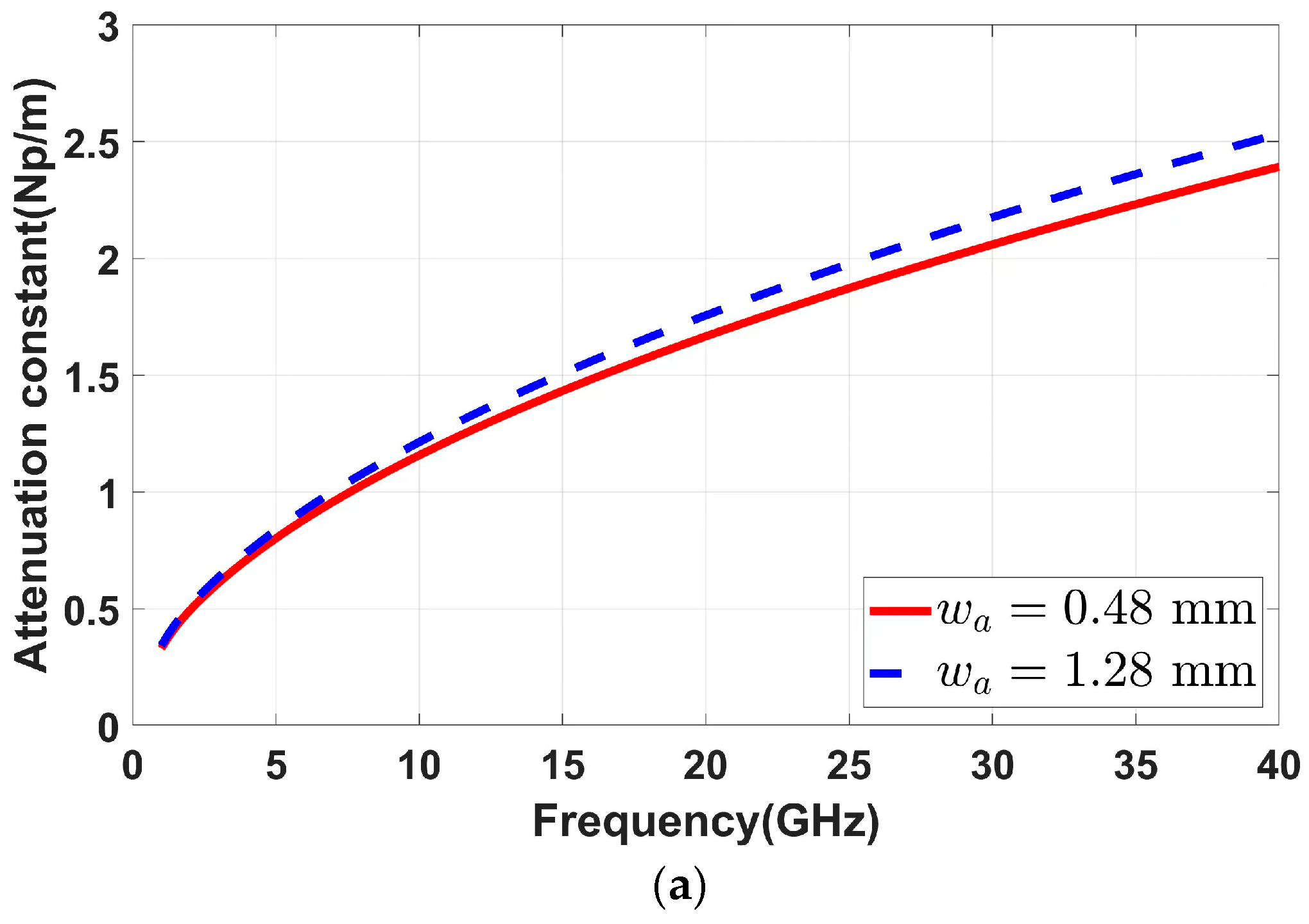

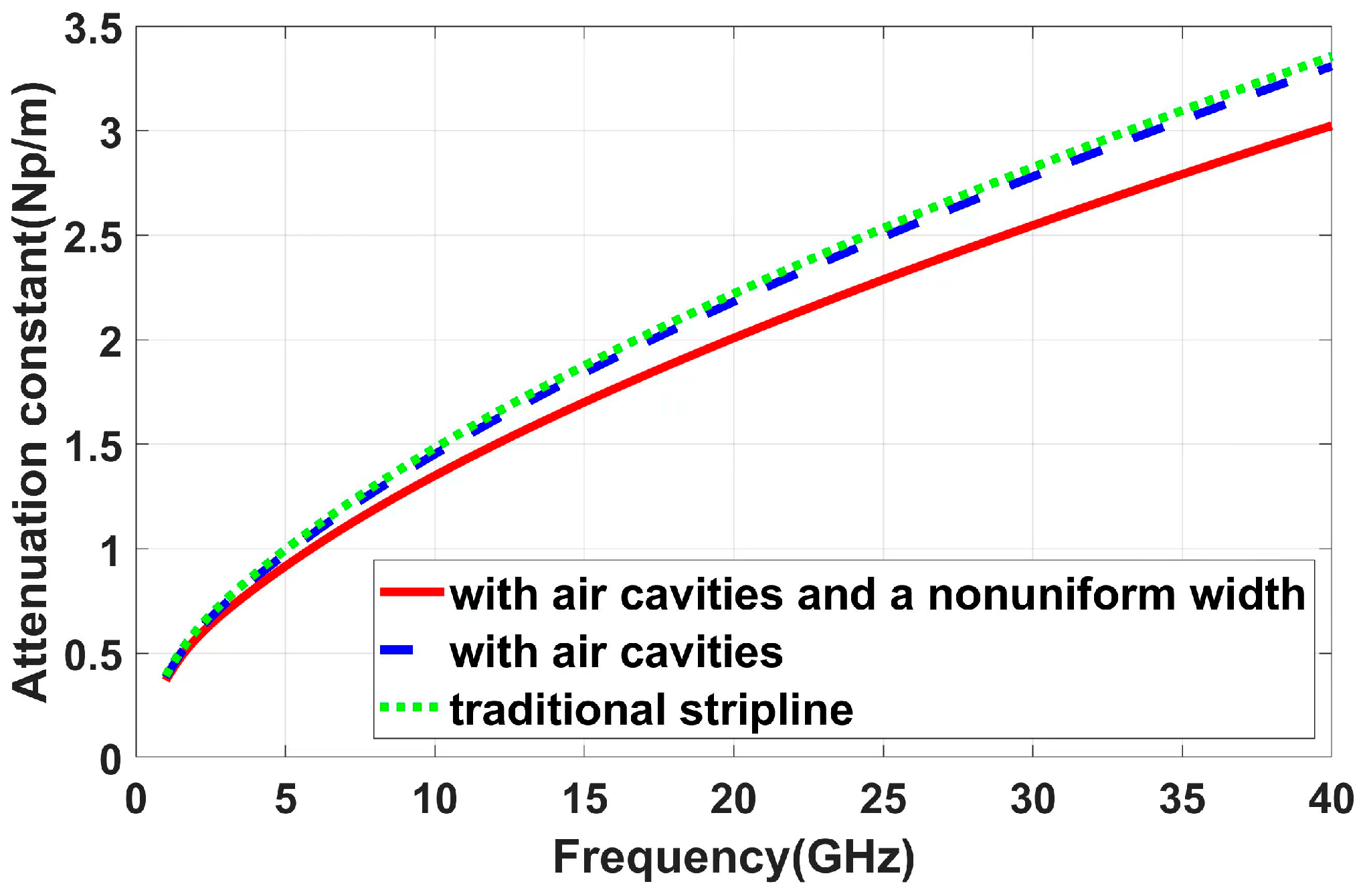
| a | b | bmax | d | da | h | l | s | sa | wa | |
|---|---|---|---|---|---|---|---|---|---|---|
| SICL | 1.170 | 0.12 | 0.175 | 0.15 | 0.2 | 0.192 | 15.22 | 0.3 | 0.3 | 0.39 |
| stripline | - | 0.193 | 0.233 | - | 0.2 | 0.295 | 8 | - | 0.3 | 0.48 |
Disclaimer/Publisher’s Note: The statements, opinions and data contained in all publications are solely those of the individual author(s) and contributor(s) and not of MDPI and/or the editor(s). MDPI and/or the editor(s) disclaim responsibility for any injury to people or property resulting from any ideas, methods, instructions or products referred to in the content. |
© 2025 by the authors. Licensee MDPI, Basel, Switzerland. This article is an open access article distributed under the terms and conditions of the Creative Commons Attribution (CC BY) license (https://creativecommons.org/licenses/by/4.0/).
Share and Cite
Shao, Y.; Zhang, M. A Design Methodology for Low-Loss Interconnects Featuring Air Cavities and Periodically Nonuniform Widths. Appl. Sci. 2025, 15, 2799. https://doi.org/10.3390/app15052799
Shao Y, Zhang M. A Design Methodology for Low-Loss Interconnects Featuring Air Cavities and Periodically Nonuniform Widths. Applied Sciences. 2025; 15(5):2799. https://doi.org/10.3390/app15052799
Chicago/Turabian StyleShao, Yan, and Mingjie Zhang. 2025. "A Design Methodology for Low-Loss Interconnects Featuring Air Cavities and Periodically Nonuniform Widths" Applied Sciences 15, no. 5: 2799. https://doi.org/10.3390/app15052799
APA StyleShao, Y., & Zhang, M. (2025). A Design Methodology for Low-Loss Interconnects Featuring Air Cavities and Periodically Nonuniform Widths. Applied Sciences, 15(5), 2799. https://doi.org/10.3390/app15052799






